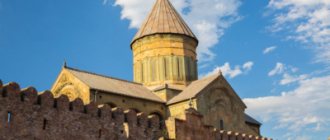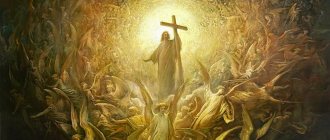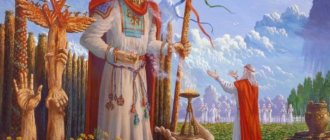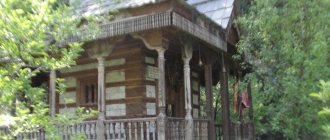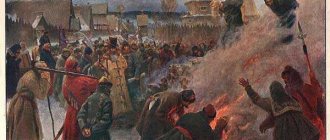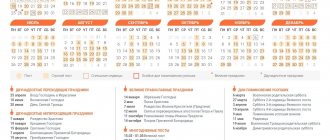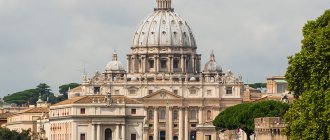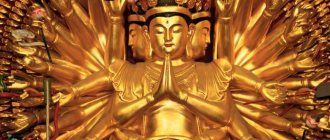The Republic of Croatia is a Christian state
Croatia (Croatian: Hrvatska), officially the Republic of Croatia (Croatian: Republika Hrvatska) is a state in south-central Europe or southern Europe, partly in the west of the Balkan Peninsula.
It was formed on the site of three historical lands of the Croatian crown - Croatia proper (or Lesser Croatia), Dalmatia and Slavonia, as well as the former Margraviate of Istria. Previously part of the former Yugoslavia. In 1991 it became independent.
Map of Croatia. Croatia is a secular state, but it is dominated by the Catholic Church. Photo: upload.wikimedia.org
The country's constitution guarantees freedom of religion, while the Catholic Church in the country does not have state status, although it actually receives public funding and enjoys a number of privileges from the state. A number of Catholic holidays have been declared state holidays:
- Epiphany - January 6, Monday after Easter.
- Feast of the Body and Blood of Christ.
- Dormition of the Virgin Mary - August 15.
- All Saints' Day is November 1st.
- Christmas is December 25th.
- St. Stephen's Day is December 26th.
Solemn procession with the Holy Gifts on the Feast of the Body and Blood of Christ.
In Croatia, some Catholic holidays are considered public holidays. Photo: upload.wikimedia.org At the same time, the laws of the country stipulate that citizens professing another religion have the right to replace Catholic holidays with holidays of their denomination, without going to work on these days. Religious education classes are available in public schools, but attendance is not compulsory.
The Croatian Catholic Radio broadcasts in the country, and every Sunday on the central TV channel there is a live broadcast of a mass from one of the Croatian churches.
Croatia is a secular state, but the Catholic Church dominates it.
It is quite easy to understand which religion is dominant among the Croats. The fact is that according to the 2011 national census, 3,697,143 people, or 86.28% of the total population of the country, consider themselves Catholics.
Thus, the dominant religion in Croatia is Catholicism. The overwhelming majority of the Croatian Catholic population belongs to the Latin rite; 6,219 people (0.14%) consider themselves Greek Catholics.
As for religious minorities, Christian denominations dominate among them: Orthodox (mainly ethnic Serbs), Muslims, Protestants (Adventists, Baptists, Methodists, Calvinists, Lutherans, Pentecostals, etc.), Jehovah's Witnesses. In addition, Jews and Muslims also live in the country.
Invasion
On May 1-3, 1995, the Croatian army carried out Operation Lightning, capturing Western Slavonia, which was part of the Republic of Serbian Krajina. The Serbian protests led to nothing - the international community responded to this aggressive act only with half-hearted declarations. The military situation in the Serbian Krajina became extremely complicated.
By the beginning of August 1995, the armed formations of the Serbian Krajina numbered from 27 to 34 thousand people, about 300 tanks, 295 infantry fighting vehicles and 360 large-caliber guns.
The total strength of the Croatian army at this time was approaching 250 thousand people, of which 150 thousand were involved in the actions of the “Storm” plan. More than 230 tanks, 161 armored personnel carriers and infantry fighting vehicles, 320 large-caliber guns, 26 combat aircraft and 10 combat helicopters were in service.
Operation Storm also involved the Bosnian Muslim Army's 25,000-strong 5th Corps.
At 2 a.m. on August 4, 1995, Croatian representative Hrvoje Sarinic officially notified the commander of the UN peacekeeping unit, General Janvier, about the start of the operation. The pretext given was the Serbian offensive on the Croat-controlled city of Bihac, which had already ceased by that time.
At 5 a.m. on August 4, Croatian artillery and aviation launched a massive attack on Serbian troops, as well as on populated areas of the Serbian Krajina. Following this, Croatian “commandos” went into battle and, while capturing UN observation posts, killed and wounded several peacekeepers.
Serbian Krajina. A Russian checkpoint on the line of fire between Croatian and Serbian units near the town of Orolik. Photo: RIA Novosti / Vladimir Vyatkin
Most Croatian Christians practice Catholicism
Christianity in Croatia has always been the most widespread religion in the country. Thus, as of 2010, there were 4.11 million Christians living in Croatia, who made up 93.4% of the population of this country. In addition, as of the same year, there were 2,077 Christian churches and places of worship in Croatia, which belonged to 33 different denominations.
93,4%
how many Christians were there in Croatia as of 2010
Thus, we can accurately answer the question: what is the main faith of Serbs and Croats. In addition, Christianity in the Republic of Croatia is also professed by: Italians, Albanians, Romanians, Hungarians, Slovenes, Czechs, Slovaks, Montenegrins, Macedonians, Germans, Ukrainians, Ruthenians, etc.
Cathedral of St. Douai, Split. Most Croats consider themselves Catholics. Photo: upload.wikimedia.org
Christianity appeared in Croatia in the 9th century. It is worth noting that here Slavic worship existed in parallel with Latin and was a Roman mass celebrated in Church Slavonic and with liturgical books in Glagolitic. The Glagolitic rite finally disappeared from use only in the middle of the 20th century.
After the schism of the Christian Church in 1054, the Croatian Church remained in communion with the Bishop of Rome, despite close political ties with Byzantium. Union with the Kingdom of Hungary contributed to strengthening the position of the Catholic Church in the country.
93,4 %
Croatian population is Catholic
After the country lost its independence, the Croatian Church enjoyed significant autonomy within first the Kingdom of Hungary and then Austria-Hungary. In 1687, the Croatian parliament officially proclaimed St. Joseph as the country's patron saint.
After the collapse of Austria-Hungary, Croatia became part of Yugoslavia. As Yugoslavia entered a period of disintegration, ethnic tensions between Catholic Croats, Orthodox Serbs and Bosnian Muslims began to be exacerbated by religious conflicts.
During the hostilities during the civil war, a large number of Catholic and Orthodox churches were destroyed.
Church of St. Joseph in Dubrovnik. Saint Joseph is officially recognized as the patron saint of Croatia. Photo: rutraveller.ru
After Croatia gained independence, the Croatian Conference of Catholic Bishops was founded. Currently, the Catholic Church is the largest religious organization in the country.
These are mainly Catholics of the Latin rite. In addition, some Croats consider themselves Greek Catholics (10 thousand). There are also several Old Catholic organizations present in the country, the largest of which is the Croatian Old Catholic Church (6 thousand believers in 12 parishes).
2011 Census
Religions in Croatia according to the 2011 census[1]:
In absolute numbers
| Number | Catholics | Orthodox | Protestants | Other Christians | Muslims | Jews | Eastern religions | Other religions | Agnostics | Atheists, non-religious | Not indicated | Unknown | |
| Croats | 3 874 321 | 3 599 038 | 16 647 | 8 042 | 10 502 | 9 647 | 231 | 1 969 | 1 924 | 27 076 | 124 811 | 69 789 | 4 645 |
| Albanians | 17 513 | 7 109 | 2 | 2 | 13 | 9 594 | — | 2 | 22 | 43 | 273 | 414 | 39 |
| Austria | 297 | 206 | 1 | 6 | 9 | 3 | 2 | 3 | — | 4 | 37 | 26 | — |
| Bosnians | 31 479 | 317 | 293 | 16 | 23 | 27 959 | — | 5 | 14 | 308 | 1 613 | 904 | 27 |
| Bulgarians | 350 | 81 | 158 | 9 | 8 | 2 | — | 2 | 2 | 9 | 63 | 14 | 2 |
| Montenegrins | 4 517 | 379 | 1 822 | 21 | 36 | 159 | — | 9 | 14 | 266 | 1 459 | 347 | 5 |
| Czechs | 9 641 | 8 521 | 12 | 242 | 35 | 1 | — | 8 | 5 | 92 | 445 | 243 | 37 |
| Hungarians | 14 048 | 9 396 | 78 | 3 344 | 205 | — | 2 | 6 | 8 | 83 | 522 | 356 | 48 |
| Macedonians | 4 138 | 494 | 2 401 | 33 | 51 | 217 | — | 7 | 6 | 98 | 591 | 231 | 9 |
| Germans | 2 965 | 1 847 | 22 | 494 | 46 | 5 | 1 | 6 | 9 | 45 | 319 | 161 | 10 |
| Poles | 672 | 585 | 6 | 3 | 3 | — | — | — | 1 | 8 | 34 | 29 | 3 |
| Gypsies | 16 975 | 8 299 | 2 381 | 62 | 177 | 5 039 | — | 2 | 124 | 25 | 255 | 414 | 197 |
| Romanians | 435 | 186 | 147 | 14 | 31 | — | — | 1 | 1 | 2 | 29 | 22 | 2 |
| Russians | 1 279 | 209 | 729 | 10 | 21 | 9 | — | 6 | 3 | 32 | 162 | 97 | 1 |
| Rusyns | 1 936 | 1 692 | 89 | 11 | 25 | — | — | — | — | 18 | 75 | 25 | 1 |
| Slovaks | 4 753 | 3 159 | 12 | 1 242 | 38 | — | — | 3 | 1 | 27 | 134 | 120 | 17 |
| Slovenians | 10.517 | 8 081 | 37 | 81 | 68 | 9 | — | 6 | 8 | 245 | 1 469 | 473 | 40 |
| Serbs | 186 633 | 2 391 | 159 530 | 350 | 657 | 24 | 6 | 72 | 56 | 2 099 | 17 385 | 3 896 | 167 |
| Italians | 17 807 | 15 083 | 26 | 26 | 57 | 6 | 3 | 25 | 17 | 233 | 1 579 | 682 | 70 |
| Turks | 367 | 5 | — | — | — | 343 | — | — | — | 1 | 11 | 6 | 1 |
| Ukrainians | 1 878 | 1 339 | 341 | 6 | 14 | — | — | 2 | 1 | 18 | 87 | 68 | 2 |
| Moldovans | 29 | 4 | 11 | — | 1 | — | — | — | 1 | 2 | 6 | 4 | — |
| Jews | 509 | 14 | 3 | 1 | 3 | — | 266 | 2 | 2 | 30 | 147 | 39 | 2 |
| Other | 8.052 | 1 913 | 816 | 451 | 156 | 2 361 | 10 | 272 | 83 | 169 | 1 142 | 642 | 37 |
| The entire population of Croatia | 4 284 889 | 3 697 143 | 190 143 | 14 653 | 12 961 | 62 977 | 536 | 2 550 | 2 555 | 32 518 | 163 375 | 93 018 | 12 460 |
In percentages
| Number | Catholics | Orthodox | Protestants | Other Christians | Muslims | Jews | Eastern religions | Other religions | Agnostics | Atheists, non-religious | Not indicated | Unknown | |
| Croats | 3 874 321 | 92,9 % | 0,4 % | 0,2 % | 0,3 % | 0,2 % | 0,0 % | 0,1 % | 0,0 % | 0,7 % | 3,2 % | 1,8 % | 0,1 % |
| Albanians | 17 513 | 40,6 % | 0,0 % | 0,0 % | 0,1 % | 54,8 % | 0,0 % | 0,1 % | 0,2 % | 1,6 % | 2,4 % | 0,2 % | |
| Austria | 297 | 69,4 % | 0,3 % | 2,0 % | 3,0 % | 1,0 % | 0,7 % | 1,0 % | 1,3 % | 12,5 % | 8,8 % | ||
| Bosnians | 31 479 | 1,0 % | 0,9 % | 0,1 % | 0,1 % | 88,8 % | 0,0 % | 0,0 % | 1,0 % | 5,1 % | 2,9 % | 0,1 % | |
| Bulgarians | 350 | 23,1 % | 45,1 % | 2,6 % | 2,3 % | 0,6 % | 0,6 % | 0,6 % | 2,6 % | 18,0 % | 4,0 % | 0,6 % | |
| Montenegrins | 4 517 | 8,4 % | 40,3 % | 0,5 % | 0,8 % | 3,5 % | 0,2 % | 0,3 % | 5,9 % | 32,3 % | 7,7 % | 0,1 % | |
| Czechs | 9 641 | 88,4 % | 0,1 % | 2,5 % | 0,4 % | 0,0 % | 0,1 % | 0,1 % | 1,0 % | 4,6 % | 2,5 % | 0,4 % | |
| Hungarians | 14 048 | 66,9 % | 0,6 % | 23,8 % | 1,5 % | 0,0 % | 0,0 % | 0,1 % | 0,6 % | 3,7 % | 2,5 % | 0,3 % | |
| Macedonians | 4 138 | 11,9 % | 58,0 % | 0,8 % | 1,2 % | 5,2 % | 0,2 % | 0,1 % | 2,4 % | 14,3 % | 5,6 % | 0,2 % | |
| Germans | 2 965 | 62,3 % | 0,7 % | 16,7 % | 1,6 % | 0,2 % | 0,0 % | 0,2 % | 0,3 % | 1,5 % | 10,8 % | 5,4 % | 0,3 % |
| Poles | 672 | 87,1 % | 0,9 % | 0,4 % | 0,4 % | 0,1 % | 1,2 % | 5,1 % | 4,3 % | 0,4 % | |||
| Gypsies | 16 975 | 48,9 % | 14,0 % | 0,4 % | 1,0 % | 29,7 % | 0,0 % | 0,7 % | 0,1 % | 1,5 % | 2,4 % | 1,2 % | |
| Romanians | 435 | 42,8 % | 33,8 % | 3,2 % | 7,1 % | 0,2 % | 0,2 % | 0,5 % | 6,7 % | 5,1 % | 0,5 % | ||
| Russians | 1 279 | 16,3 % | 57,0 % | 0,8 % | 1,6 % | 0,7 % | 0,5 % | 0,2 % | 2,5 % | 12,7 % | 7,6 % | 0,1 % | |
| Rusyns | 1 936 | 87,4 % | 4,6 % | 0,6 % | 1,3 % | 0,9 % | 3,9 % | 1,3 % | 0,1 % | ||||
| Slovaks | 4 753 | 66,5 % | 0,3 % | 26,1 % | 0,8 % | 0,1 % | 0,0 % | 0,6 % | 2,8 % | 2,5 % | 0,4 % | ||
| Slovenians | 10 517 | 76,8 % | 0,4 % | 0,8 % | 0,6 % | 0,1 % | 0,1 % | 0,1 % | 2,3 % | 14,0 % | 4,5 % | 0,4 % | |
| Serbs | 186 633 | 1,3 % | 85,5 % | 0,2 % | 0,4 % | 0,0 % | 0,0 % | 0,0 % | 0,0 % | 1,1 % | 9,3 % | 2,1 % | 0,1 % |
| Italians | 17 807 | 84,7 % | 0,1 % | 0,1 % | 0,3 % | 0,0 % | 0,0 % | 0,1 % | 0,1 % | 1,3 % | 8,9 % | 3,8 % | 0,4 % |
| Turks | 367 | 1,4 % | 93,5 % | 0,3 % | 3,0 % | 1,6 % | 0,3 % | ||||||
| Ukrainians | 1 878 | 71,3 % | 18,2 % | 0,3 % | 0,7 % | 0,1 % | 0,1 % | 1,0 % | 4,6 % | 3,6 % | 0,1 % | ||
| Moldovans | 29 | 13,8 % | 37,9 % | 3,4 % | 3,4 % | 6,9 % | 20,7 % | 13,8 % | |||||
| Jews | 509 | 2,8 % | 0,6 % | 0,2 % | 0,6 % | 52,3 % | 0,4 % | 0,4 % | 5,9 % | 28,9 % | 7,7 % | 0,4 % | |
| Other | 8 052 | 23,8 % | 10,1 % | 5,6 % | 1,9 % | 29,3 % | 0,1 % | 3,4 % | 1,0 % | 2,1 % | 14,2 % | 8,0 % | 0,5 % |
| The entire population of Croatia | 4 284 889 | 86,3 % | 4,4 % | 0,3 % | 0,3 % | 1,5 % | 0,0 % | 0,1 % | 0,1 % | 0,8 % | 3,8 % | 2,2 % | 0,3 % |
Orthodoxy in Croatia is mainly practiced by Serbs
Why is religion needed?
What faith is popular among Croats besides Catholicism can be understood by studying the ethnographic map of the country. The fact is that most Croats are Catholics, and Serbs are mainly Orthodox.
Currently, the following are represented on the territory of the Republic: the Serbian Orthodox Church, the Bulgarian Orthodox Church and the Macedonian Orthodox Church, which are officially recognized by the state.
According to the 2011 census, the number of Orthodox Christians in Croatia was 190,143, representing 4.44% of the country's population.
Serbian Transfiguration Cathedral in Zagreb. The majority of Orthodox Christians in Croatia are Serbs. Photo: upload.wikimedia.org
Orthodox Croatian Serbs are canonically included in the Zagreb-Ljubljana Metropolis and three other dioceses of the Serbian Orthodox Church. On the territory of Croatia there are a number of Orthodox monasteries that were built back in the Middle Ages.
The most famous among them are: Dragović Monastery, Krka Monastery, Krupa Monastery, Lepavina Monastery and Gomirje Monastery.
190 143
so many people in the country are Orthodox
During the Yugoslav Civil War and the Serbo-Croatian conflict, many Serbian Orthodox churches in Croatia were destroyed. Some of them were restored by the Croatian authorities with the help of the Serbian diaspora. In general, the situation of Orthodox Christians in Croatia remains quite difficult.
Emblem of the Macedonian Orthodox Church. Representatives of several local Orthodox churches are present in Croatia. Photo: upload.wikimedia.org
It is worth noting that representatives of non-canonical Orthodoxy are also active in the Republic of Croatia. A number of Orthodox communities in Croatia belong to non-canonical national Orthodox autocephalies. The Macedonian Orthodox Church has 4 parishes in the country, one parish each from the Montenegrin Orthodox Church and the revived Croatian Orthodox Church.
In addition, representatives of Old Calendar Orthodox churches also live here. These are the so-called Mattheites-Kirikites from the True Orthodox Church of Greece (followers of Metropolitan Kirik).
The illusion of peace
In 1994, the situation became relatively stabilized. In March, a truce was signed between the Serbian Krajina and Croatia. Croatian Serbs tried to establish a peaceful life. In December 1994, bilateral documents were signed on the restoration of economic ties, and negotiations were envisaged on the return of refugees, the payment of pensions, and the opening of railway communications.
The position of the international community regarding the conflict in Serbia was extremely similar to that expressed today regarding the Ukrainian crisis. Europeans and Americans, while recognizing Croatia's right to independence, categorically denied the right to self-determination to the Croatian Serbs. The so-called Zagreb 4 plan, put forward in January 1995, provided for autonomy for the Knin Krajina within Croatia, as well as full integration without any additional rights for other Serbian territories.
However, this option, which was an infringement of the rights of the Serbs, was not acceptable to official Zagreb. Franjo Tudjman believed that he could completely resolve the “Serbian issue” without any concessions.
Photo: www.globallookpress.com
Croats, along with Catholicism, profess Protestantism
Many people ask: what faith do Croats profess besides Catholicism? This faith is Protestantism. At the same time, large Protestant communities also exist among Hungarians, Slovaks, Germans, and Gypsies. The English and Czechs living in the country also profess this religion.
Lutheran Church in Zagreb. Ethnic Croats profess Protestantism in addition to Catholicism
Protestantism began to spread in Croatia in the 16th century in the form of Lutheranism and Reformation. Protestants did not have significant influence in the country until the 18th century. The situation changed when thousands of Germans began to move to Croatia.
This happened during the First World War, when more than 100,000 Lutherans moved to Croatia. After World War II, many Germans returned to Germany. The communist authorities of Yugoslavia pursued a policy of persecution against Protestants, as a result of which the number of parishioners of the Lutheran Church fell from 130 thousand to 5 thousand believers.
Ethnic Croats profess Protestantism in addition to Catholicism.
The Reformed Church spread among ethnic Hungarians. At the end of the 19th and beginning of the 20th centuries, a number of evangelical Protestant movements began missionary activity in Croatia.
The first regular Baptist services in Croatia began in 1883 in Daruvar. Methodists began active ministry in Croatia in 1895. As for the Pentecostals, they arrived in the country in 1907.
Baptist Church in Zagreb. In addition to Lutherans, representatives of other Protestant denominations live in Croatia. Photo: upload.wikimedia.org
In our time, during the population census in 2011, 15 thousand residents of Croatia called themselves Protestants. However, these data are not entirely accurate and there may be 12–100 thousand more Protestants in the Republic of Croatia.
As of 2013, none of the national Croatian churches were members of the World Council of Churches. A number of the country's evangelical churches work together in the Protestant Evangelical Council. The organization includes Baptists, the Church of Christ and part of the Pentecostals.
Milosevic's concessions ended in death in prison
The European Union condemned the seizure of the Serbian Krajina, but did not take serious measures. A harsh statement was made only by Swedish diplomat Carl Bildt , who was the EU mediator in negotiations between Croatia and the Serbian Krajina. Bildt directly blamed Croatian President Franjo Tudjman for the incident, saying: “I heard from the Croatian ministers that they are planning to expel 99 percent of the Serbs from the Serbian Krajina.”
A separate conversation about the position of Yugoslavia. The Republic was connected with the Serbian Krajina by a treaty on military assistance, but did not intervene in the events. This decision by President Slobodan Milosevic was caused by pressure from the United States. As a reward for Yugoslavia's restraint, a relaxation of the economic sanctions regime was promised.
Slobodan Milosevic's policy of concessions did not help Yugoslavia. A few years later, the United States and NATO would tear Kosovo away from Serbia with the help of military aggression, and Milosevic himself would be overthrown during the “Bulldozer Revolution”, accused of war crimes and killed in the prison of the International Tribunal in The Hague.
Photo: www.globallookpress.com
In Croatia, representatives of marginal Christianity are officially recognized
Representatives of marginal Christianity are officially recognized and active in the Republic of Croatia. The vast majority of them are members of the Jehovah's Witnesses organization.
It was registered by Croatian authorities as a religious organization in 2003. This was done by representatives of the local Ministry of Justice. According to the organization’s own data, in 2012 there were 5.5 thousand baptized publishers living in Croatia and 66 congregations operating.
Bust of Krešimir Cosic at the Mirogoj cemetery. The Mormon community became popular in Croatia after the famous basketball player Krešimir Cosić became a member. Photo: upload.wikimedia.org
As for the Church of Jesus Christ of Latter-day Saints, it was registered in the country as a legal entity by the Yugoslav communist authorities in 1975. In the same year, the first Mormon community appeared in Croatian Zadar.
This community became popular when the famous Yugoslav athlete Krešimir Cosić joined it. Currently, according to the church’s own data, there are 6 congregations in Croatia, uniting about 600 parishioners.
Blitz War Plan
On November 15, 1994, the United States and Croatia entered into a military cooperation agreement. As part of it, the United States provided assistance to Croatia in training its armed forces. Military advisers from the American private military company MPRI participated in the training of Croatian special units and guards brigades. A special intelligence center was created to collect information and listen to negotiations of the Serbian side.
In December 1994, the Croatian General Staff began preparations for Operation Storm, which provided for the complete defeat of Serbian forces and the liquidation of the Republic of Serbian Krajina. According to Croatian Foreign Minister Mate Granic , the United States advised the Croatian army on the conduct of this offensive. Retired American generals, as employees of private military campaigns, did not leave Zagreb, preparing for the blitzkrieg.
Article on the topic
"Others can think what they want." How Gavrilo Princip became a hero of Serbia
Plan Storm envisioned a lightning operation that would last several days, leaving little time for the international community to intervene. At the same time, it was intended to exert political pressure on Serbia in order to prevent its intervention in the conflict.
Islam came to Croatia from the Ottoman Empire
Islam in Croatia appeared in the Middle Ages, it was brought here by subjects of the Ottoman Empire. The fact is that the Muslim Ottoman Empire owned part of Croatia from the 15th to the 19th centuries. Ottoman rule left a deep imprint on the culture and religion of the country.
So some Croats converted from Christianity to Islam. Since 1519, in Western Europe, Croatia has been known as the “avant-garde of Christianity” (lat. Antemurale Christianitatis), this name was given to the country by Pope Leo X. This fact is connected with the fact that it was in Croatia that the Ottoman advance deeper into Christian Europe was stopped.
Mosque in Zagreb. Islam was brought to Croatia by officials of the Ottoman Empire. Photo: upload.wikimedia.org
At the same time, the penetration of Croatian and Ottoman civilization was mutual. Chronicles say that the names of many of the Ottoman Empire were of Croatian origin. In addition, they also spoke excellent Croatian. During World War II, the Mufti of Zagreb was Ismet Muftić, who held this position since 1917. In 1945, he was hanged by Tito's partisans in front of his mosque.
1,47 %
Croatian population professes Islam
Nowadays, the capital of Croatia, Zagreb, has one of the largest and most beautiful new mosques in Europe. The leader of the Muslim community in Croatia and the Mufti of Zagreb is Imam Ševko Omerbasic. In 2013, a new mosque was built in the city of Rijeka. At the same time, not everyone in the Republic of Croatia likes the plans of the country’s Muslim community to build new mosques. In Dubrovnik, for example, the local council rejected plans to build a mosque on the top of a mountain behind the old town.
Mosque in Rijeka. The mosque in Croatian Rijeka is considered the most beautiful in Europe. Photo: gdb.rferl.org
Most Croatian Muslims are Turks. In addition, Roma and Albanians also accepted Islam. As for the number of Muslims in the country, as of 2011, Muslims make up approximately 1.47% of the population of Croatia.
Links
Political system Constitution • Government • Parliament • Administrative division • Foreign policy Geography Cities • Capital • Population • Languages • Climate • Extreme points • Islands • Lakes • Mountains • Mammals • Rivers of Croatia • Topography of Croatia Story Pre-Slavic Croatia • Origin of the Croats • White Croatia • Maritime Croatia • Pannonian Croatia • Kingdom of Croatia • Union with Hungary • Dubrovnik Republic • Habsburg Empire • Kingdom of Croatia and Slavonia • State of Slovenes, Croats and Serbs • Kingdom of Yugoslavia (Croatian Banovina) • People's Liberation war (Croatia at war • NGH) • SR Croatia • War in Croatia • History since 1995 • Accession to the European Union Economy Currency • Zagreb Stock Exchange • CROBEX • Brands • Energy • Croatian People's Bank • Privatization • Transport • Tourism (national parks • world heritage) Connection Media (Broadcasting • Radio stations • Television • Press • Internet (.hr) • Post (history and stamps) Army Military History • Armed Forces (Ground Forces • Navy • Coast Guard • Air Force and Air Defense • Luchko Group • Special Operations Battalion) • Military ranks Culture Architecture • Religion • Cinema • Literature • Music (Eurovision) • National costume • Croatian weaving • Holidays • Sports (Football • Ice Hockey • Basketball • Handball • Athletics • Olympic Games) • Education • Science Portal "Croatia"
The Jewish community in Croatia is relatively small
Data from archaeological excavations indicate that Jews lived on the territory of modern Croatia already in the 2nd and 3rd centuries. In the 14th – 15th centuries, when the main part of the country was under the rule of the Hungarian kings, Jewish families lived in Zagreb, but already in 1456 they were expelled.
In 1526, when the Croatian nobility recognized Ferdinand of Austria as their overlord, Jews were prohibited from coming to Croatia.
Zagreb Synagogue. Photo from 1906. Demolished in 1942 as part of the persecution of Jews organized by the Croatian authorities supporting Nazi Germany
In 1782 - 89 Emperor Joseph II issued a series of “toleration decrees” that abolished many anti-Jewish restrictions. As a result, followers of Judaism were allowed to stay in Croatia.
The council adopted a resolution on the final emancipation of Croatian Jewry only in October 1873. Croatian Ustasha nationalists actively supported Hitler's policies during World War II.
1500
how many Jews lived in the country in 1991
Their leader A. Pavelich carried out genocide of the Jewish population. The revival of the Jewish community in Croatia began with the Republic's independence in the 1990s. In 1991, approximately 1,500 Jews lived in the country. In modern times, due to immigration to Israel and the civil war in the former Yugoslavia, their numbers have decreased significantly.
By leaving a comment, you accept the user agreement
Content
- 1 Largest cities
- 2 Orthodoxy in Croatia 2.1 History
- 2.2 Saints
- 4.1 Krka Monastery
- 5.1 Cathedral of the Assumption of the Blessed Virgin Mary (Sibenik)
Links[edit]
- Christian shrines of Croatia
- Orthodox churches in Croatia
- Croatian Orthodox Church
- On the history of the Orthodox Church in Croatia (commentary in the light of faith)
- Orthodox Croatia
- Croatia. Orthodox churches on the coast of Croatia
- Orthodox Church of St. Nicholas
- Serbian Orthodox Church of the Blessed Virgin Mary
- ORTHODOXY IN CROATIA: many people are united by the Orthodox faith
- Liturgy at the Krupa Monastery, Croatia
- Good News of Orthodoxy: November 2007
- Archbishop of Genocide. Deacon Vladimir Vasilik
- Creation and activity of the Croatian Orthodox Church during the Second World War
- Russian church emigration and the activities of the Croatian Orthodox Church in 1942–1945. Part I
- Russian church emigration and the activities of the Croatian Orthodox Church in 1942–1945. Part II
Temples[edit]
See the list of all churches in Croatia HERE
.
Cathedral of the Assumption of the Blessed Virgin Mary (Sibenik)[edit]
The Cathedral of the Assumption of the Blessed Virgin Mary in Sibenik is the largest Orthodox church in the city, located next to the bishop's residence of the Dalmatian diocese of the Serbian Orthodox Church. The Church of the Assumption of the Blessed Virgin Mary is the main church of the Dalmatian diocese. The cathedral has a rich sacristy, which contains more than a hundred icons made in the Byzantine style (XV-XIX centuries), as well as a large collection of liturgical objects and manuscripts.
Until 1808, the building of the Cathedral of the Assumption of the Blessed Virgin Mary belonged to a Benedictine convent (XIV century), and the church at that time was called the Holy Savior (XII century). Subsequently, it came into the possession of the Serbian Orthodox Church. The church acquired its current appearance in the 18th century, when the magnificent baroque bell towers by Ivan Skok were built. Thanks to this reconstruction, the church became a unique building of its kind on the entire Adriatic coast.
Address:
Zagrebačka ul., 22000, Sibenik, Croatia
Church of the Annunciation of the Blessed Virgin Mary and Museum of Icons (Dubrovnik)[edit]
The Annunciation Church was built in 1877 and is known for its unique collection of icons. The temple belongs to the Serbian Orthodox Church.
In 1907, the church purchased the building located next door. This building once belonged to the aristocratic Bond family, and currently houses a museum of icons. The museum displays a unique collection of valuable and rare icons dating from the 15th to 19th centuries, as well as antique furniture, religious artifacts, such as a facsimile edition of the Miroslav Gospel of 1897 and the Gospel in Russian in a metal cover of 1805, printed in Moscow. In the museum you can see busts of Vuk Stefanović Karadzic, a Serbian philologist, linguist and reformer of the Serbian language, and Ivan Gundulic, a Dubrovnik poet of the Baroque era, etc.
The church also owns a library with about 12 thousand books. In addition to liturgical books in Church Slavonic, there are various thematic books in French, Russian, Italian and other languages.
Address:
Ulica od Puca 8, 20000, Dubrovnik
Church of the Prophet Elijah (Zadar)[edit]
The Church of the Prophet Elijah in Zadar is an Orthodox church of the Dalmatian diocese of the Serbian Orthodox Church of the 16th century. Located in the central square of the Old Town. The Serbian Church of the Prophet Elijah with its rich and unique sacristy is one of the attractions of Zadar.
The history of the temple and its sacristy began in 1548, when the Duke of Zadar gave the existing medieval church of St. Elijah to the Greek Orthodox. In the second half of the 16th, as well as in the 17th and 18th centuries. More and more Orthodox Serbs began to arrive in Zadar. In the middle of the 18th century, this church was taken over by the Serbian Orthodox community. It was rebuilt in the late Baroque style, and at the same time a bell tower was erected in 1773.
The Church of the Prophet Elijah in Zadar houses a valuable collection of church relics. These are ancient icons of the 16th-18th centuries, which were collected in the church during its existence. This is the largest collection of icons in Dalmatia. In the sacristy you can also see liturgical vessels made of precious metals, mainly by the Venetians or Russians in the 18th-19th centuries, crosses, church clothes, an interesting collection of antimensions, numerous liturgical books printed in Venice and Moscow and Buda, Serbian and Greek manuscripts.
Address:
SS 3, Trg Serdara Stojana Jankovića, 23000, Zadar, Croatia
Telephone:
+38523251014
Email:
Shrines[edit]
Lepavinsky Monastery:
- original “Lepavinskaya” icon of the Mother of God.
The relics of ancient Christian saints in Croatia are located in Catholic churches:
DUBROVNIK.
Cathedral of St. Blaise. Relics:
- microwave Blaise of Sebastia (IV century) (head and hand).
SPLIT.
Cathedral of St. Domnius. Relics:
- microwave Domniy (Duye) (IV century) (head and part of the relics).
ZADAR.
Cathedral of St. Anastasia. Relics:
- mts. Anastasia the Pattern Maker (IV century) (part of the relics).
Church of St. Simeon. Relics:
- right Simeon the God-Receiver (part of the relics).
ZLARIN ISLAND.
Church of the Assumption of the Virgin Mary. Relics:
- martyr Fortunata (IV century)
Rovinj.
Church of St. Euphemia. Relics:
- VMC. Euphemia of All Praise (IV century)
MAKARSKA.
Church of St. Mark. Relics:
- svschmch. Clement of Rome (1st century) (part of the relics)
WORK ISLAND
Church of St. Justina (Museum of Religious Art). Relics:
- St. martyr Christopher (III century) (chapter)
